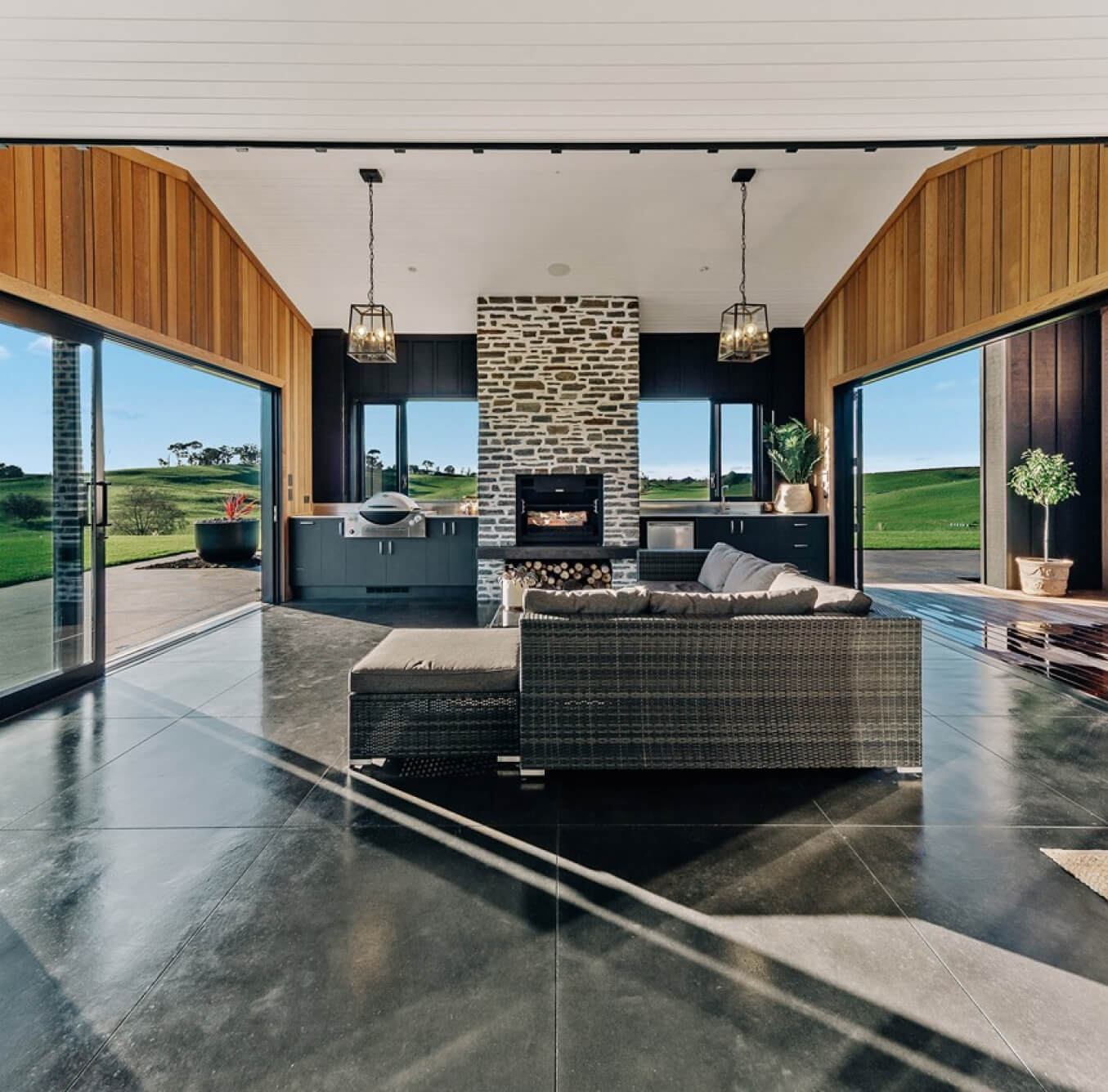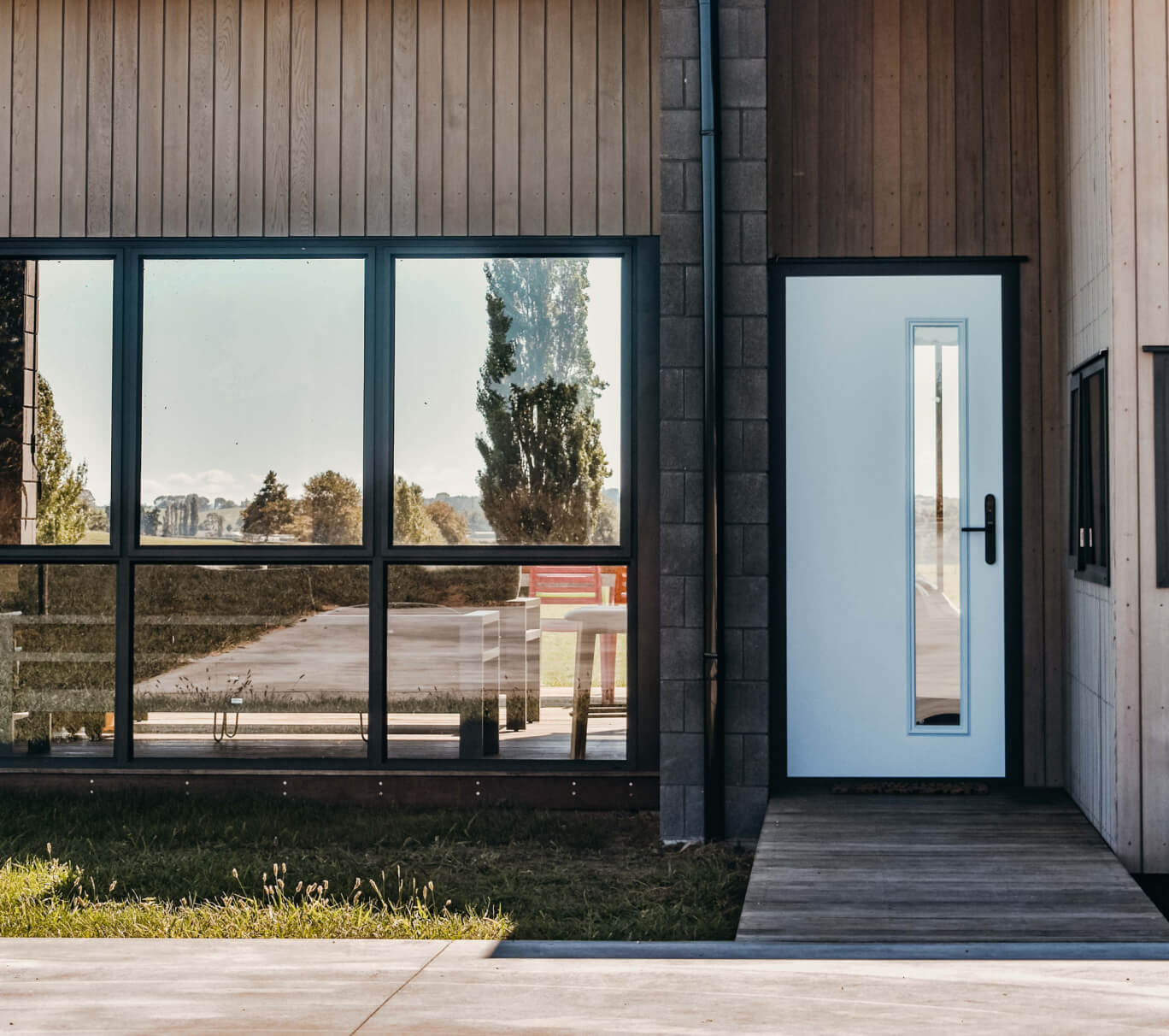What’s the Difference Between Bifold and Sliding Doors?
Bifold doors are made with a minimum of two door panels that fold against themselves in a concertina style when opened. The doors run on tracks, and the panels are connected by hinges that make up the carriage system when opened.
Bifold doors can reveal your entire opening because they can be folded away. The seamless connection between an outdoor space and an internal living area makes them a great option for open-plan living. They can also include an access door, which allows easy access without having to slide back all of the doors.
Pros of bifold doors
-
Seamless indoor-outdoor flow: Fully retractable panels create a wide, open connection between inside and outside.
-
Optional traffic door: Allows convenient everyday access without opening the entire door set.
-
Highly customisable: Available in various sizes, panel configurations, and finishes to suit different spaces.
-
Flexible opening styles: Can be designed to open either inwards or outwards, depending on your layout.
-
Lightweight aluminium frames: Easy to operate while maintaining strength and durability.
-
Enhances property value: Adds a premium, contemporary feel that can increase a home's market appeal.
-
Low threshold options: Offers easier accessibility and a cleaner visual transition.
- Versatile sizing: Suitable for both compact spaces and wide openings.
Cons of bi-fold doors
-
Requires stacking space: Panels need room to fold inside or outside the home when fully open.
- More visible framing: Multiple panels can result in thicker sightlines and a slightly more interrupted view than sliding doors.
Sliding doors are a popular choice for homeowners with limited space as they do not require as much space to open up, fold back, and store. They are comprised of two or more glass panels that move to the side, and the panes slot behind one another.
Sliding doors provide a complete view and are ideal for large openings where you want to enjoy as much natural light as possible. Sliding doors, unlike bi-fold doors, don’t provide a complete opening as the doors must slide back against each other so one pane is always visible.
Pro’s of Sliding doors:
-
Space-saving design: Sliding doors don’t require swing room, making them ideal for tighter spaces than French or bi-fold doors.
-
Minimal sightlines: Slim frames maximise glass area and offer a sleek, modern look.
-
Effortless operation: Lightweight aluminium frames allow the doors to glide smoothly and easily.
- Uninterrupted views: Large glass panels provide expansive, near-unobstructed views whether the doors are open or closed.
Con’s of sliding doors
-
Less convenient for quick entry/exit: Unlike French doors or bi-folds with a traffic door, sliding doors require one panel to move for access.
-
Potentially higher cost: Sliding doors can be more expensive than French or bi-fold alternatives, depending on the system and materials.
- Limited flush threshold: Due to the roller system, a completely flush track isn’t possible, although tracks can be recessed into the floor for a smoother transition.
Comparing sliding doors and bi-fold doors
Thermal efficiency
Winner - Draw
Most sliding doors have more glass and fewer frames, which enhances thermal efficiency if they are double-glazed. Most modern bifold doors have a function called a thermal break, which retains heat just as well, making them both equally as thermally efficient.
Ease of access
Winner - Bi-fold doors
Bi-folds can be completely folded away for a wide opening, ideal for high-traffic areas. Many configurations include a traffic door, which functions like a traditional door for everyday access.
Sliding doors, however, always require the glass panels to be slid open. While convenient, they’re not quite as flexible as a traffic door for quick ins and outs. Bi-fold doors offer the flexibility of being completely folded away, creating a wide opening, which is perfect for areas with high foot traffic. Many bi-fold door configurations also include a traffic door for daily entry and exit, functioning like a traditional door.
Space saving
Winner - Sliding Doors
Because sliding doors move horizontally within their own track, they don’t take up additional interior or exterior space. This makes them perfect for smaller homes or tight patio areas.
Bi-folds require stacking space when opened inside or outside the home, which may impact room layout or furniture placement. Sliding doors are ideal for smaller homes or tight patio areas because they don't use any extra interior or exterior space as they move horizontally within their own track.
Bi-fold doors, on the other hand, need stacking space when opened, either inside or outside the home, which can affect room layout or furniture placement.
Views outside when shut
Winner - sliding doors
When closed, sliding doors typically offer the clearest view of your outdoor space. Thanks to larger individual glass panels and minimal framing, they provide a sleek, uninterrupted visual connection to the outside.
That said, high-quality aluminium bi-folds can also deliver impressive views with panel widths up to 1.2m and ultra-slim frames, closing the gap. Sliding doors have the largest glass panels and the least framing, offering the clearest view of the outdoors when closed. They provide an uninterrupted view and a sleek, modern look.
Views outside when open
Winner - bifold doors
Bi-fold doors are an excellent option for creating a completely open space. They fold away to the sides, eliminating nearly all visual and physical barriers between indoors and outdoors. While some sliding systems, such as Duco Sliding Doors, allow multiple panels to stack or slide to one side, offering expansive, uninterrupted views, they don't achieve the same open feeling as fully retracted bi-fold doors.
Looking for Sliding or Bifold Doors in New Zealand?
We supply and install premium bifold and sliding doors in Waikato, New Zealand, with options for every home and budget.
Get in touch for a free consultation, and let’s create a seamless indoor-outdoor flow you’ll love.



